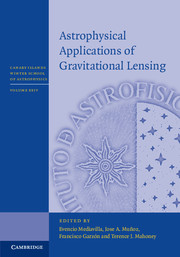Book contents
- Frontmatter
- Contents
- List of contributors
- List of participants
- Preface
- Acknowledgements
- 1 Lensing basics
- 2 Exoplanet microlensing
- 3 Four case studies of microlensing
- 4 Gravitational (micro)lensing of quasars and AGN
- 5 Dark matter in clusters and large-scale structure
- 6 The future of strong lensing
- 7 Methods for strong lens modelling
- 8 Tutorial on inverse ray shooting
Preface
Published online by Cambridge University Press: 05 September 2016
- Frontmatter
- Contents
- List of contributors
- List of participants
- Preface
- Acknowledgements
- 1 Lensing basics
- 2 Exoplanet microlensing
- 3 Four case studies of microlensing
- 4 Gravitational (micro)lensing of quasars and AGN
- 5 Dark matter in clusters and large-scale structure
- 6 The future of strong lensing
- 7 Methods for strong lens modelling
- 8 Tutorial on inverse ray shooting
Summary
This book gathers together the lectures and practical sessions imparted during the XXIVth Canary Islands Winter School of Astrophysics, held at Puerto de la Cruz, Tenerife (4–16 November 2012).
The basic phenomena of gravitational lenses, light deflection and time dilation by gravitational fields, are two essential predictions of Einstein's General Theory of Relativity. Both effects played a prominent role in the classical tests of General Relativity through famous experiments such as the deflection of light by the Sun measured by Eddington during the 1919 solar eclipse and the radar time delays first measured by Shapiro from the echoes of planets and space probes in the Solar System. Owing to rapid developments in technology, these once exotic and difficult-to-measure effects can nowadays be tested millions of times per second with a very popular device, the GPS (gravitational lensing in everyday life). The present and future importance of gravitational lenses is therefore no longer related exclusively to fundamental General Relativity but also (this is our motivation) to its use in probing the properties of astrophysical objects and of the Universe itself.
The optical bench is one of the most common pieces of laboratory apparatus in modern physics. A source emits photons, alpha particles, neutrons or some other kind of ‘bullets’ that interact with a test object (the target) and are subsequently detected by the observer. This set-up enables the researcher to change and move at will any of the components of the experiment to check hypotheses being tested. Astrophysical sources and targets (planets, stars, galaxies, etc.) are too big and distant for the astronomer to be able to manipulate them. Nevertheless, in certain rare cases a distant source (a star, galaxy, or quasar) appears to be almost aligned with an intervening target (a planet, star, galaxy, or galaxy cluster), thus allowing the observer to measure the deflection of the light rays caused by the gravitational field of the target. This is a gravitational lens system (or simply ‘gravitational lens’), an astronomical optical bench that can be used as a tool to study both the source and the deflecting target.
- Type
- Chapter
- Information
- Astrophysical Applications of Gravitational Lensing , pp. xi - xiiPublisher: Cambridge University PressPrint publication year: 2016



